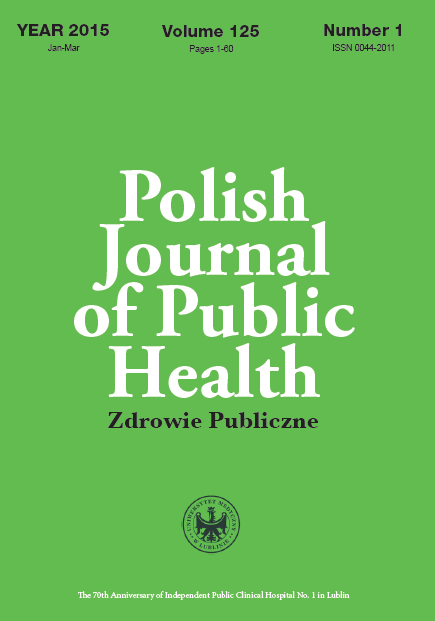Cataract surgery today and 20 years ago
DOI:
https://doi.org/10.1515/pjph-2015-0013Keywords:
cataract, phacoemulsification, ECCE, cataract surgery complicationsAbstract
Introduction. Cataract surgery is one of the most important surgical procedures in ophthalmology.
Aim. The aim of this study is to compare cataract surgeries performed in 1994 and 2014.
Material and methods. A retrospective analysis of 100 cataract procedures in 1994, as well as a total of 100 cataract procedures performed in 2014. The authors considered the following factors: age, sex, vision acuity, cataract type, preoperative patient preparation, intra- and postoperative complications, and total hospitalization time.
Results. Back in 1994, extracapsular cataract extraction (ECCE) was the most common treatment technique. It caused more intraoperative complications (46) and postoperative complications (38) and longer total hospitalization time (9.25 days±3.25 SD). In 2014, all procedures were performed using phacoemulsification. As a result, the number of intraoperative (20) and postoperative (14) complications has dropped significantly. Total hospitalization time was also reduced (1.53 days±1.08 SD).
Conclusions. Phacoemulsification significantly improved cataract treatment. This method is much safer and more effective than ECCE.
References
1. Pascolini D, Mariotti SP. Global estimates of visual impairment: 2010. Br J Ophthalmol. 2012; 96:614-8.
2. Archiwum GUS. Stan zdrowia ludności Polski w 2004 r. [http://www.stat.gov.pl/gus/5840_658_PLK_HTML.htm?action=show_archive]
3. Dostęp do opieki okulistycznej w Polsce. Podejście systemowe. Najważniejsze problemy związane z dostępem doświadczeń okulistycznych. CEESTAHC 2012. [http://www.ceestahc.org/pliki/nasze_publikacje/raporty/Dostep_do_opieki_okulistycznej_w_Polsce.pdf]
4. Soczewka i zaćma. Basic and Clinical Science Course. Section 11. 2005-2006.
5. Żarnowski T, Chmiel M, Haszcz D, Zagórski Z. Evaluation of astigmatism and blood-aqueous barrier breakdown following procedures in the anterior eye segment. Klin Oczna. 1998;100(1):11-4.
6. Szymulska M, Haszcz D, Rakowska E, Zagórski Z. Wartość badań bakteriologicznych w chirurgii zaćmy. Klin Oczna. 1996;98:125-7.
7. Apt L, Isenberg SJ, Yoshimori R, et al. The effect of povidone-iodine solution applied at the conclusion of ophthalmic surgery. Am J Ophthalmol. 1995;119:701-5.
8. Ciulla TA, Starr MB, Masket S. Bacterial endophthalmitis prophylaxis for cataract surgery: an evidence-based update. Ophthalmology. 2002;109:13-24.
9. Barry P, Cordovès L, Gardner S. Wytyczne ESCRS dotczące profilaktyki i leczenia zapalenia wnętrza gałki ocznej po operacji zaćmy: dane, dylematy i wnioski 2013. [http://www.escrs.org/endophthalmitis/guidelines/POLISH.pdf]
Downloads
Published
Issue
Section
License
Copyright (c) 2015 Polish Journal of Public Health

This work is licensed under a Creative Commons Attribution-NonCommercial-NoDerivatives 3.0 Unported License.


